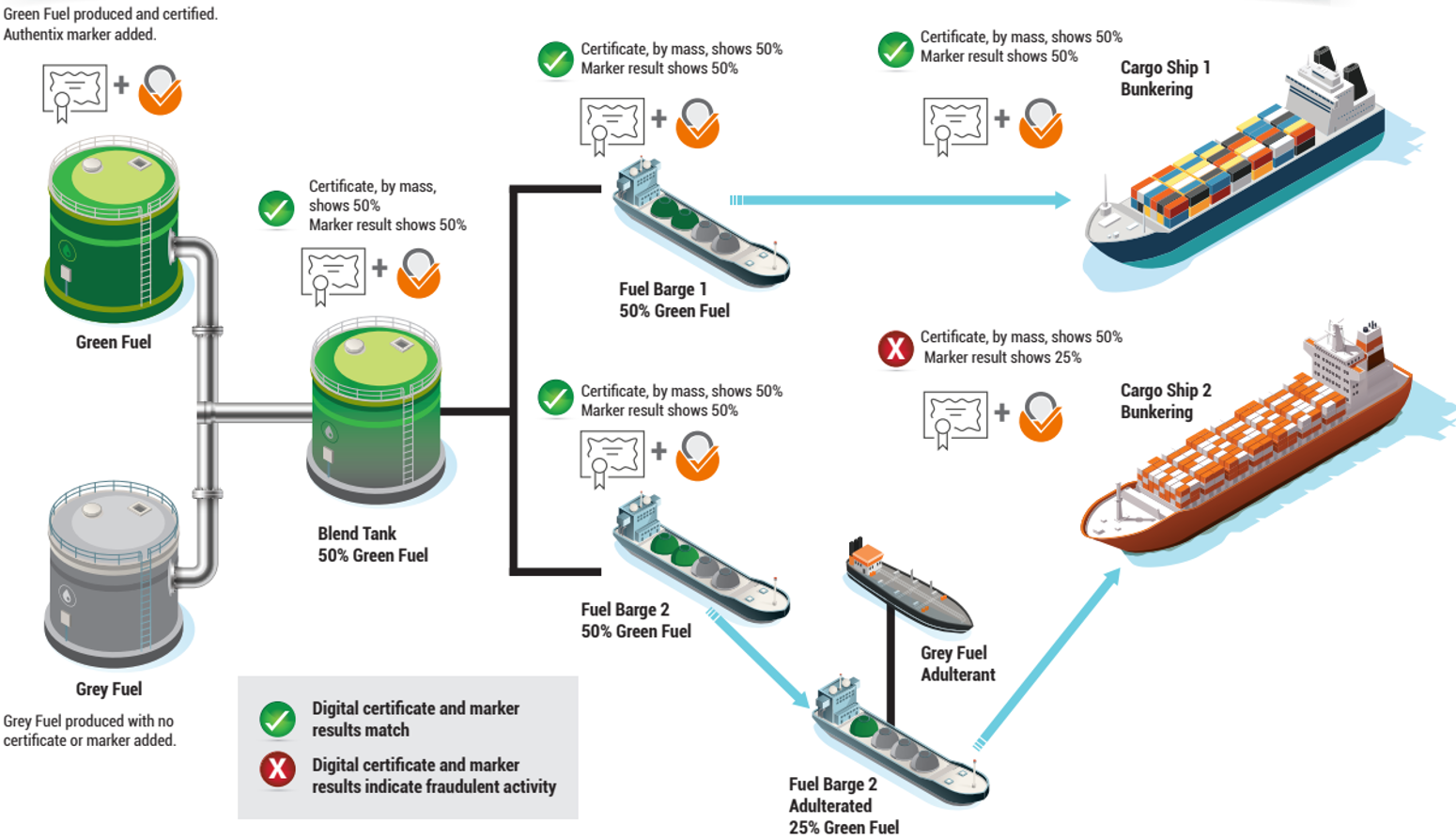Driven by environmental concerns, regulatory mandates, and the pressing need to curb greenhouse gas emissions, the global push for sustainable energy has intensified. The European Union and other regions have set ambitious targets to reduce greenhouse gas (GHG) emissions by 2030, extending up to 2050.
Verifying Sustainable Fuels: The Imperative of Physical Authentication
By Jim Seely, Vice President, Oil & Gas Solutions, Authentix, Inc.
Introduction
Driven by environmental concerns, regulatory mandates, and the pressing need to curb greenhouse gas emissions, the global push for sustainable energy has intensified. The European Union and other regions have set ambitious targets to reduce greenhouse gas (GHG) emissions by 2030, extending up to 2050.
The transport sector (encompassing land, air, and sea) is responsible for nearly one-third of GHG emissions that contribute to climate change. A comprehensive approach is being adopted across the sector to achieve significantly lower GHG emissions by 2030 and zero-carbon fuels by 2050, though this varies by organization and region.
As the world grapples with the urgent need to transition toward cleaner energy sources, sustainable fuels—ranging from biofuels to synthetic fuels, ammonia, and hydrogen—play a pivotal role. However, this transition is not without its complexities and uncertainties. Ensuring the integrity, reliability, and positive environmental impact of sustainable fuels demands a comprehensive approach.
In this white paper, we delve into the multifaceted landscape of sustainable fuels, with a specific focus on the imperative need for robust assurance mechanisms, including the capability to measure and confirm the integrity of physical products.
Carbon Intensity
Achieving environmental goals for emissions is not simply about utilizing low-carbon fuels. The production processes of these fuels significantly influence the carbon intensity of the end product. To effectively classify the various production techniques and their related greenhouse gas (GHG) emissions, color-coding schemes have been introduced. Colors such as grey, blue, green, and others are used to depict the total carbon footprint of a fuel. However, the current terminology for describing low-emission fuels is inconsistent among different stakeholders and countries, and there is no globally accepted method for calculating emission intensity at present.i The absence of a consistent system for calculating the overall carbon footprint could potentially distort the perceived environmental advantages of utilizing low-carbon fuels.
For instance, a study by the Rocky Mountain Institute (RMI) contrasted the carbon intensity of a “green” labeled hydrogen fuel, expected to have the smallest carbon footprint, with that of “grey” hydrogen fuel, anticipated to have a significantly larger carbon footprint. The study discovered that, despite labeling, the “green” hydrogen, if produced from electricity generated by fossil fuels, would have an average yearly carbon intensity nearly twice that of “grey” hydrogen, which is produced directly from natural gas without any emission abatement.ii
Owing to the vague methods of classifying low-carbon fuels with basic labels, many global organizations and governments are striving to establish certification schemes that accurately compute the carbon intensity score of low-carbon fuels and set standards for these classifications. These schemes are intended to provide transparency to the end consumer about the fuel they purchase, which is usually purchased at a premium. However, the various methods for calculating the GHG product footprint lack standardization. Without a globally recognized standard or mutually recognized standards, the landscape remains unclear and perplexing for producers and consumers. The European Court of Auditors has identified that deficiencies in the certification systems for sustainable biofuels could jeopardize the EU’s goals for renewable energy in the transportation sector.
Factors Impacting Sustainable Fuel Fraud
The production of renewable fuels can be expensive, and some “advanced” biofuels like biodiesel made from Used Cooking Oil (UCO), can be counted twice towards renewable energy goals in nations that use this method as an economic stimulus. UCO is often sold at a higher price than virgin oils, such as soybean oil. As the production of virgin oils frequently uses arable land and can lead to deforestation, the EU is promoting “advanced” biofuels, which are derived from waste products or made from UCO and animal fats. The double counting mechanism in combination with high market prices creates an incentive for illegal practices, such as using virgin oil mislabeled as UCO or mixing virgin oil into UCO.iv
This issue is made even more complex by the fact that, in most cases, the molecules generated through green processes cannot be differentiated from those produced by blue or grey methods. Even when there are chemical distinctions between the fuels, it is difficult to verify the source feedstock. For example, it is challenging with UCO to confirm if the sample genuinely originates from waste products, which would qualify it for double counting.v
This concern has proven to be valid, as it was found that 17 companies in nine countries mislabeled cheap virgin soy biofuel as expensive UCO-based fuel.vi In addition, suspicious patterns of import volumes from countries such as China, Italy, Malta, Bulgaria, Bosnia, Saudi Arabia, Kuwait and others indicate that this sustainable fuel fraud is rampant.vii Chinese imports of palm oil biodiesel from Indonesia and Malaysia have increased almost tenfold from 2021 to 2023, raising suspicions that palm oil is being used to fraudulently supplement UCO volumes.viii
These examples provided pertain to just one among many renewable fuels that are being globally mandated or otherwise incentivized. The supply chain used for sustainable fuels, whether biofuels, ammonia, or hydrogen, is complex. Often, operators don’t have clear visibility into the upstream feedstocks, production processes, and transportation methods involved. This lack of traceability leads to uncertainty, especially as these fuels can be compromised during transit and distribution before arrival at the point of sale.
Sustainable Fuel Tracking Methods
Several strategies can be used to maintain the integrity and identity of products throughout multiple custody transfers. These strategies, or chain of custody models, aim to offer transparent bookkeeping of the product’s attributes as it moves from point-to-point through the supply chain. These sustainable fuel verification tools include:
- Identity Preservation. This method refers to the process where a product with a unique identity is isolated and tracked, preventing it from being mixed with other products. An example of this would be green hydrogen sourced from a single origin and delivered directly to the end user.
- Product Segregation. This often involves the mixing of verified products from multiple sources that share similar characteristics. For instance, green hydrogen from various sources might be combined in a pipeline for delivery to the end user.
- Mass Balance. This is a method designed to monitor the total mass of a product with specific attributes throughout the distribution network. This method is meant to ensure the correct allocation of the beneficial attributes of a low-carbon fuel to the final product delivered based on auditable record-keeping. This method is typically used when the infrastructure for storage and shipping does not permit segregation. For example, a certain quantity of green hydrogen is produced, and this product is mixed with blue and grey hydrogen during transport and storage. The allocation of this green hydrogen is recorded and the final product mirrors that percentage allocation, facilitating the advantages of low-carbon production without complete product segregation.
- Book & Claim. This approach separates the tangible, certified product from the certificates or carbon credits linked to it. Thus, the low-carbon product can be mixed with any other products without the need for separation or monitoring of the mass input into the system. This is advantageous when production is distinct from consumption and the transportation of the low-carbon product is not feasible. Certificates or credits can be purchased and sold to ‘exchange’ the benefits of low-carbon fuel production with end users who cannot acquire low-carbon fuel.
In the Book & Claim model, where a renewable product of high value is rapidly separated from its corresponding carbon credits, the chances for fraudulent misrepresentation are reduced. However, establishing an international Book & Claim system with a unified carbon market or harmonizing diverse markets to allow products to flow smoothly through the global supply chain presents numerous challenges. Consequently, the Mass Balance model is more prevalent and simpler to implement due to these complexities. Here, and also with the segregation and identity preservation models, renewable product has a period of isolation from non-renewable products and the risk of misrepresentation and fraud rise significantly. However, even with the Mass Balance model, there are stakeholders that are concerned that the “existing rules on Mass Balance bookkeeping are not aligned with the realities of marine fuel logistics,” where floating storage, bunker barge last point before consumption exists and fuel production is often far from ports.ix
If low-carbon fuels possess a distinct, permanent fingerprint that consistently marks them as the initially certified substance, then genuine product assurance and verification can be achieved, no matter what chain of custody procedure is used. However, as discussed earlier, there is no inherent signature of a fuel produced by low carbon methods versus that produced by high emitting methods when the final molecules are identical.
The following diagram was taken from Enabling a Circular Economy for Chemicals with the Mass Balance Approach: A White Paper From Co.Project Mass Balance Ellen MacArthur Foundation in 2019. It has been modified to include where physical authentication can be a critical component of any assurance scheme. Whether segregated or mixed, if the identity and proportion of low-carbon fuel can be confirmed, the level of confidence in the assurance scheme is significantly enhanced.

Figure 1: Various chain of custody models, indicating where verification of sustainable certification can be accomplished
Carbon Isotopes for Identification of Origin
In some cases, an inherent fingerprint exists in fuels that can provide an identification of their origins, offering insights into their adherence to specific regulations and incentives. Carbon isotope analysis proves instrumental in verifying whether biofuels originate from biological sources.  This technique involves examining the proportions of carbon isotopes. Isotopes are variants of the same chemical element, differentiated only by their neutron count, which affects their mass, rendering some isotopes marginally lighter or heavier. By detecting these mass differences, one can ascertain the isotope ratios and, at times, pinpoint the original feedstock. Specifically for biofuels, the isotopes carbon-12, carbon-13, and carbon-14 are analyzed using the ASTM D6866 method. This allows for the distinction between biofuels derived from plant materials and those from fossil fuel sources based on isotopic ratios. Additionally, this approach is employed to calculate the plant-based biofuel content within a blended fuel.
This technique involves examining the proportions of carbon isotopes. Isotopes are variants of the same chemical element, differentiated only by their neutron count, which affects their mass, rendering some isotopes marginally lighter or heavier. By detecting these mass differences, one can ascertain the isotope ratios and, at times, pinpoint the original feedstock. Specifically for biofuels, the isotopes carbon-12, carbon-13, and carbon-14 are analyzed using the ASTM D6866 method. This allows for the distinction between biofuels derived from plant materials and those from fossil fuel sources based on isotopic ratios. Additionally, this approach is employed to calculate the plant-based biofuel content within a blended fuel.
Although this method can identify whether a fuel is derived from biological or fossil origins, it is not capable of distinguishing between all types of feedstocks. For example, the updated Renewable Energy Directive mandates a transition from traditional biofuels, which are produced using virgin plant materials from agricultural lands, to advanced biofuels made from non-recyclable waste. Given that both sources are plant-based, carbon isotope analysis cannot separate these two groups.
For other types of low-carbon fuels, there may be no intrinsic differences. For example, ammonia generated via Steam Methane Reformation (SMR) of natural gas, a process associated with significant greenhouse gas emissions, is chemically the same as ammonia produced from hydrogen and nitrogen powered by renewable energy. When fuels are chemically identical, introducing a unique marker becomes essential to differentiate between sources. In cases where fuels are chemically identical, the only solution is to introduce a distinct marker to identify one source from another. However, it raises the question: are there commercially viable methods to uniquely label renewable fuels?
Innovative Tracking Solution Using Traceable Fuel Markers
Capitalizing on its 25 years of experience in safeguarding the integrity of global fuel distribution, Authentix provides a broad range of fuel markers for identifying compromises from adulterants and diverted products as fuels traverse the supply chain. These markers can be added to both fossil and biofuels at extremely low concentrations, even in the parts per billion (ppb) range. Despite their minute presence, the sustainable fuel tracking solution allows for the quantitative measurement of any product compromise, whether due to the diversion of unauthorized product from an untrusted source or by contamination with other low-cost or substandard additives.
The following diagram illustrates two scenarios of supplying low-carbon, green fuel to a bunkering container ship. In both scenarios, a green fuel supplier has been certified by an internationally recognized scheme and also adds an Authentix marker to the product in their tank. This product is now traced with both a digital certificate and a marker. In addition, high GHG grey fuel is produced from another fuel supplier without any certificate or marker. Due to infrastructure constraints, the green and grey fuels are mixed in a single blend tank. The updated certificate, based on mass balance, indicates that 50% of the product in the tank is green, and the Authentix marker results confirm the accuracy of the digital certificate.
Two fuel barges are loaded from this tank. Barge #1 goes straight to the awaiting cargo ship, and the fuel is authenticated before loading. The Authentix marker result aligns with the digital certificate, and the load is verified and accepted for ship bunkering. Barge #2, however, makes a covert stop along its route, where non-compliant grey fuel is transferred onto the barge. When this barge reaches its destination, it only contains 25% green fuel, half of the required amount. Despite the digital certificate claiming 50% green fuel, the Authentix marker reveals that the product has been tampered with, indicating some illegal activity. As a result, the load is rejected, and further investigation confirms the fuel adulteration.
Sustainable Fuel Authentication Required to Assure Low-Carbon Compliance

Figure 2: Two scenarios of supplying low-carbon, green fuel to a bunkering container ship
Conclusion
The current verification methods for sustainable fuel classifications have significant limitations. However, innovative technology solutions that accurately and swiftly verify these classifications will be crucial for a successful transition to green fuels. Organizations currently struggle with the lack of clear visibility and verification of renewable fuel products within existing supply chains. Authentix, as a market leader and pioneer, is developing game-changing technologies. These innovations will enable traceability, verification, and classification of sustainable fuels. Such emerging technology advancements will detect and prevent the abuse and illicit trade so often used to wrongly claim economic incentives and circumvent imposed regulations necessary to complete this green transition to renewable fuels.
If you’d like to learn more about how Authentix can help your sustainable fuel authentication initiatives, visit our Green Fuel Verification Solutions page or contact us today.
To download a pdf version of the paper, click here.
- “Why clearer terminology for hydrogen could unlock investment and scale up production” International Energy Agency, June 2023.
- “Hydrogen Reality Check: All “Clean Hydrogen” Is Not Equally Clean” RMI, October 2022.
- “Certifying biofuels: weaknesses in recognition and supervision of the system” European Court of Auditors, July 2016.
- “Used Cooking Oil (UCO) as biofuel feedstock in the EU” CE Delft, December 2020.
- “Research for TRAN Committee: Assessment of the potential of sustainable fuels in transport” ANNEXES (europa.eu), March 2023.
- “How Biofuels Scams Have Undermined A Flagship EU Climate Policy” OCCRP, July 2023.
- “New biofuel data triggers fresh fraud concerns over EU imports” S&P Global Commodity Insights (spglobal.com), December 2023.
- “To tackle biofuel fraud, Ireland takes matters into its own hands” Euractiv, October 2023.
- “Fuel Certifications – Needs of a shipping and logistics company” Maersk, May 2022.
Related Articles
News & Updates
Global Centre for Maritime Decarbonisation: Tracer Trials to Authenticate and Quantify Biofuel Volumes
The Global Centre for Maritime Decarbonisation (GCMD) recently released a report detailing the results of its pilot on the efficacy of different tracer candidates to…
LEARN MOREGovernments
On Demand Webinar: Refrigerants at Risk: Securing the Supply Chain from Smuggling to Counterfeiting
Authentix VP of Oil and Gas Solutions, Jim Seely, sat down with the ERC Environmentally Applied Refrigerant Technology Hub (EARTH) team to discuss security markers,…
LEARN MORE